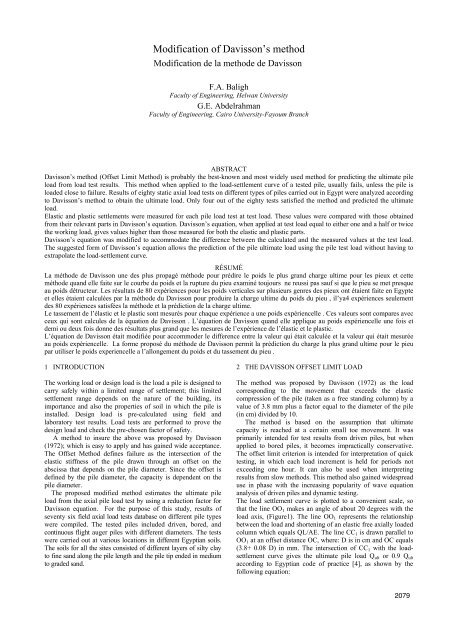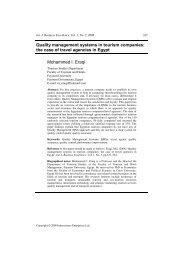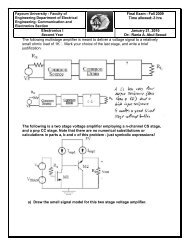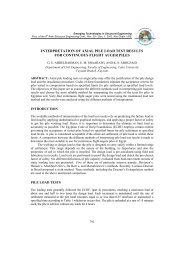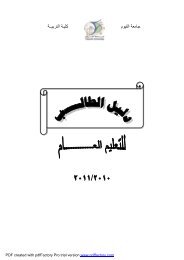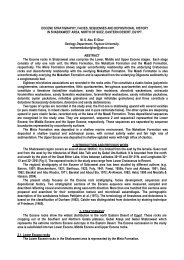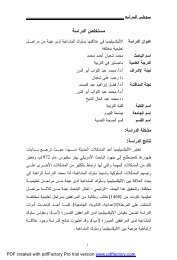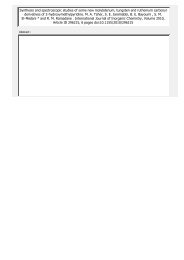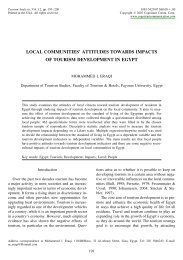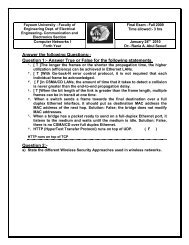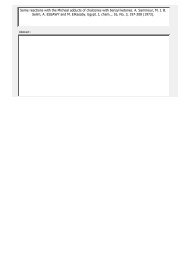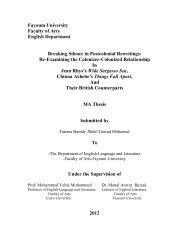Modification of Davisson's method
Modification of Davisson's method
Modification of Davisson's method
Create successful ePaper yourself
Turn your PDF publications into a flip-book with our unique Google optimized e-Paper software.
<strong>Modification</strong> <strong>of</strong> Davisson’s <strong>method</strong><br />
<strong>Modification</strong> de la <strong>method</strong>e de Davisson<br />
F.A. Baligh<br />
Faculty <strong>of</strong> Engineering, Helwan University<br />
G.E. Abdelrahman<br />
Faculty <strong>of</strong> Engineering, Cairo University-Fayoum Branch<br />
ABSTRACT<br />
Davisson’s <strong>method</strong> (Offset Limit Method) is probably the best-known and most widely used <strong>method</strong> for predicting the ultimate pile<br />
load from load test results. This <strong>method</strong> when applied to the load-settlement curve <strong>of</strong> a tested pile, usually fails, unless the pile is<br />
loaded close to failure. Results <strong>of</strong> eighty static axial load tests on different types <strong>of</strong> piles carried out in Egypt were analyzed according<br />
to Davisson’s <strong>method</strong> to obtain the ultimate load. Only four out <strong>of</strong> the eighty tests satisfied the <strong>method</strong> and predicted the ultimate<br />
load.<br />
Elastic and plastic settlements were measured for each pile load test at test load. These values were compared with those obtained<br />
from their relevant parts in Davisson’s equation. Davisson’s equation, when applied at test load equal to either one and a half or twice<br />
the working load, gives values higher than those measured for both the elastic and plastic parts.<br />
Davisson’s equation was modified to accommodate the difference between the calculated and the measured values at the test load.<br />
The suggested form <strong>of</strong> Davisson’s equation allows the prediction <strong>of</strong> the pile ultimate load using the pile test load without having to<br />
extrapolate the load-settlement curve.<br />
RÉSUMÉ<br />
La méthode de Davisson une des plus propagé méthode pour prédire le poids le plus grand charge ultime pour les pieux et cette<br />
méthode quand elle faite sur le courbe du poids et la rupture du pieu examiné toujours ne reussi pas sauf si que le pieu se met presque<br />
au poids détructeur. Les résultats de 80 expériences pour les poids verticales sur plusieurs genres des pieux ont étaient faite en Egypte<br />
et elles étaient calculées par la méthode du Davisson pour produire la charge ultime du poids du pieu , il’ya4 expériences seulement<br />
des 80 expériences satisfées la méthode et la prédiction de la charge ultime.<br />
Le tassement de l’élastic et le plastic sont mesurés pour chaque expérience a une poids expériencelle . Ces valeurs sont compares avec<br />
ceux qui sont calcules de la équation de Davisson . L’équation de Davisson quand elle applique au poids expériencelle une fois et<br />
demi ou deux fois donne des résultats plus grand que les mesures de l’expérience de l’élastic et le plastic.<br />
L’équation de Davisson était modifiée pour accommoder le difference entre la valeur qui était calculée et la valeur qui était mesurée<br />
au poids expériencelle. La forme proposé du méthode de Davisson permit la prédiction du charge la plus grand ultime pour le pieu<br />
par utiliser le poids experiencelle a l’allongement du poids et du tassement du pieu .<br />
1 INTRODUCTION<br />
The working load or design load is the load a pile is designed to<br />
carry safely within a limited range <strong>of</strong> settlement; this limited<br />
settlement range depends on the nature <strong>of</strong> the building, its<br />
importance and also the properties <strong>of</strong> soil in which the pile is<br />
installed. Design load is pre-calculated using field and<br />
laboratory test results. Load tests are performed to prove the<br />
design load and check the pre-chosen factor <strong>of</strong> safety.<br />
A <strong>method</strong> to insure the above was proposed by Davisson<br />
(1972); which is easy to apply and has gained wide acceptance.<br />
The Offset Method defines failure as the intersection <strong>of</strong> the<br />
elastic stiffness <strong>of</strong> the pile drawn through an <strong>of</strong>fset on the<br />
abscissa that depends on the pile diameter. Since the <strong>of</strong>fset is<br />
defined by the pile diameter, the capacity is dependent on the<br />
pile diameter.<br />
The proposed modified <strong>method</strong> estimates the ultimate pile<br />
load from the axial pile load test by using a reduction factor for<br />
Davisson equation. For the purpose <strong>of</strong> this study, results <strong>of</strong><br />
seventy six field axial load tests database on different pile types<br />
were compiled. The tested piles included driven, bored, and<br />
continuous flight auger piles with different diameters. The tests<br />
were carried out at various locations in different Egyptian soils.<br />
The soils for all the sites consisted <strong>of</strong> different layers <strong>of</strong> silty clay<br />
to fine sand along the pile length and the pile tip ended in medium<br />
to graded sand.<br />
2 THE DAVISSON OFFSET LIMIT LOAD<br />
The <strong>method</strong> was proposed by Davisson (1972) as the load<br />
corresponding to the movement that exceeds the elastic<br />
compression <strong>of</strong> the pile (taken as a free standing column) by a<br />
value <strong>of</strong> 3.8 mm plus a factor equal to the diameter <strong>of</strong> the pile<br />
(in cm) divided by 10.<br />
The <strong>method</strong> is based on the assumption that ultimate<br />
capacity is reached at a certain small toe movement. It was<br />
primarily intended for test results from driven piles, but when<br />
applied to bored piles, it becomes impractically conservative.<br />
The <strong>of</strong>fset limit criterion is intended for interpretation <strong>of</strong> quick<br />
testing, in which each load increment is held for periods not<br />
exceeding one hour. It can also be used when interpreting<br />
results from slow <strong>method</strong>s. This <strong>method</strong> also gained widespread<br />
use in phase with the increasing popularity <strong>of</strong> wave equation<br />
analysis <strong>of</strong> driven piles and dynamic testing.<br />
The load settlement curve is plotted to a convenient scale, so<br />
that the line OO1 makes an angle <strong>of</strong> about 20 degrees with the<br />
load axis, (Figure1). The line OO 1 represents the relationship<br />
between the load and shortening <strong>of</strong> an elastic free axially loaded<br />
column which equals QL/AE. The line CC1 is drawn parallel to<br />
OO1 at an <strong>of</strong>fset distance OC, where: D is in cm and OC equals<br />
(3.8+ 0.08 D) in mm. The intersection <strong>of</strong> CC1 with the loadsettlement<br />
curve gives the ultimate pile load Q ult or 0.9 Q ult<br />
according to Egyptian code <strong>of</strong> practice [4], as shown by the<br />
following equation:<br />
2079
S ult = (0.08 *D+3.8) + (Q ultL/AE) (1)<br />
Where: S ult: settlement (mm) <strong>of</strong> pile at ultimate load, D:<br />
diameter <strong>of</strong> the pile at the pile tip (cm), Qult: ultimate load (ton),<br />
A: base area <strong>of</strong> the pile (mm 2 ), E: modulus <strong>of</strong> elasticity <strong>of</strong> the<br />
pile material (2 ton/mm 2 ) and L: length <strong>of</strong> the pile shaft (mm).<br />
Settlement, S<br />
0 50 100 150 200 250<br />
Qult<br />
300 350<br />
0<br />
O<br />
2<br />
4<br />
6<br />
8 C<br />
10<br />
12<br />
14<br />
16<br />
18<br />
20<br />
Figure 1. The Offset Limit Method (after Davisson 1972).<br />
In Davisson’s Offset Limit Method, the predicted failure load<br />
value tends to be conservative [3]. The actual limit line can be<br />
drawn on the load-settlement curve already before starting the<br />
test. The ultimate load can, therefore, be used as an acceptance<br />
criterion to pro<strong>of</strong> tested piles in contract specifications. This<br />
<strong>method</strong> is not suitable for tests that involve loading and<br />
unloading cycles.<br />
3 PROPOSED DAVISSON MODIFICATION<br />
Davisson’s <strong>method</strong> can not be applied unless the pile is loaded<br />
close to failure. The problem is that in most static load tests<br />
where the pile is loaded to one and a half or twice the design<br />
load, failure rarely occurs. For this reason it was found<br />
necessary to modify Davisson’s <strong>method</strong> so as to estimate the<br />
ultimate pile load from the test load.<br />
For the purpose <strong>of</strong> this study, results <strong>of</strong> seventy six axial load<br />
tests on different pile types (driven, bored and augered), lengths<br />
and diameters were considered as shown in table (1) for one and<br />
half the working load and table (2) for twice the working load.<br />
Brinch-Hansen, (1961, 1963) considered that the shape <strong>of</strong><br />
the pile load-settlement curve is a parabolic curve which can be<br />
calculated by using the following equation:<br />
S = a Q 2<br />
(2)<br />
a = 1/ (C 1 S + C 2) 2<br />
Where S is pile settlement at pile load Q, C 1 and C 2 are<br />
constants, for the same pile load test. At test load equation (2)<br />
can be written as follows:<br />
STL = a Q TL 2<br />
Where S TL is pile settlement at pile load test, and Q TL is the test<br />
pile load.<br />
By dividing equation (2) at ultimate load by equation (4) the<br />
following relation was obtained:<br />
Qult 2 = Q TL 2 [Sult / S TL] (5)<br />
Ultimate pile settlement, Sult, was taken according to Davisson<br />
(1972), as in equation (1) and pile settlement at test load, STL,<br />
can be written in a similar form:<br />
S TL= (0.08 D+ 3.8) + (Q TL L /A E) (6)<br />
2080<br />
Load, Q<br />
QL/AE O1<br />
C1<br />
(3)<br />
(4)<br />
Table 1: Results <strong>of</strong> Axial Load Tests for One and Half the<br />
Working Load<br />
Test L D<br />
Test<br />
load<br />
(ton)<br />
No m mm 1.5 W.L Elastic<br />
Sett.<br />
Measured settlement at<br />
Test Load<br />
(mm)<br />
Plastic<br />
Sett.<br />
Total<br />
Sett..<br />
Dr1 13 450 67.5 1.85 0.38 2.23<br />
Dr2 17.5 500 67.5 4.00 0.41 4.40<br />
Dr3 14.75 530 120 2.43 0.33 2.75<br />
Dr4 22.25 430 75 2.68 0.12 2.80<br />
Dr5 19.3 400 60 2.18 1.62 3.80<br />
Dr6 15 400 60 1.98 0.40 2.38<br />
Dr7 26.5 600 195 4.37 0.67 5.04<br />
Dr8 13 400 80 2.98 1.30 4.28<br />
B9 22.85 800 262.5 0.94 1.13 2.06<br />
B10 13.1 500 105 2.09 1.19 3.27<br />
B11 11 500 75 1.02 0.97 1.99<br />
B12 12 500 85 1.59 2.57 4.16<br />
B13 14.55 600 90 0.49 0.26 0.75<br />
B14 13.35 450 52.5 0.62 0.32 0.94<br />
B15 13.5 800 187.5 1.48 4.25 5.73<br />
B16 17.25 600 150 2.19 2.37 4.56<br />
B17 12.5 800 240 2.62 7.78 10.40<br />
B18 13 600 153.75 5.23 5.04 10.27<br />
B19 22.5 600 120 0.90 0.58 1.48<br />
B20 21 600 75 1.15 0.33 1.48<br />
B21 14.8 400 45 1.21 0.20 1.41<br />
B22 20 600 150 0.96 1.63 2.58<br />
B23 20 600 157.5 2.45 1.56 4.01<br />
B24 13.35 450 52.5 0.56 0.32 0.88<br />
F25 18 650 210 2.48 1.33 3.81<br />
F26 18 600 180 2.95 1.29 4.24<br />
F27 18 600 180 3.22 1.65 4.87<br />
F28 14 600 120 1.33 0.75 2.08<br />
F29 14 600 120 1.24 0.28 1.52<br />
F30 14 600 120 0.99 0.66 1.65<br />
F31 13.6 400 45 1.78 2.22 4<br />
F32 13.6 400 45 1.22 1.65 2.87<br />
F33 12 600 90 0.63 0.54 1.17<br />
F34 13.2 400 30 0.48 0.26 0.74<br />
F35 12.2 400 30 0.46 0.23 0.69<br />
F36 12.2 400 30 0.49 0.26 0.75<br />
F37 15 400 30 0.41 0.21 0.62<br />
F38 12.2 400 30 0.35 0.37 0.72<br />
F39 21 500 97.5 0.79 0.57 1.36<br />
F40 21 500 97.5 1.77 0.57 2.34<br />
F41 15 600 150 2.95 3.3 6.25<br />
F42 25 400 55.5 0.81 0.37 1.18
Table 2: Results <strong>of</strong> Axial Load Tests for Twice the Working<br />
Load<br />
Test L D<br />
Test<br />
load<br />
(ton)<br />
No m mm 2 W.L<br />
Measured settlement at<br />
Test Load<br />
Elastic<br />
Sett.<br />
(mm)<br />
Plastic<br />
Sett.<br />
Total<br />
Sett.<br />
Dr1 23 500 120 1.79 0.55 2.33<br />
Dr2 17 430 80 2.65 0.79 3.44<br />
Dr3 13.6 500 95 2.00 0.56 2.56<br />
Dr4 20 400 50 2.30 0.59 2.89<br />
Dr5 26 450 90 2.26 1.65 3.91<br />
Dr6 19.7 400 60 1.30 0.12 1.41<br />
Dr7 11.75 400 70 0.92 0.71 1.63<br />
Dr8 23.75 400 70 2.82 0.29 3.11<br />
Dr9 12 500 34 0.91 0.36 1.26<br />
Dr10 14.75 400 70 1.68 0.63 2.31<br />
Dr11 17.2 400 128 1.17 0.39 1.56<br />
Dr12 19.5 400 80 5.27 2.30 7.57<br />
Dr13 12 400 80 1.16 0.25 1.41<br />
Dr14 19.5 450 50 0.49 0.09 0.58<br />
Dr15 23.5 450 90 3.06 1.20 4.26<br />
B16 25.2 800 350 2.72 2.27 4.99<br />
B17 13.5 500 120 2.16 4.10 6.26<br />
B18 14 600 130 2.68 2.82 5.50<br />
B19 14 600 130 2.57 3.10 5.67<br />
B20 15.5 600 120 3.21 1.49 4.70<br />
B21 17.5 800 350 8.65 5.74 14.39<br />
B22 12.8 800 350 5.88 9.30 15.18<br />
B23 17 800 120 6.65 10.74 17.39<br />
B24 18 800 340 6.35 5.27 11.62<br />
B25 20 800 350 3.55 1.81 5.36<br />
B26 16.5 600 147 1.67 2.155 3.82<br />
F27 19.6 600 210 3.27 0.42 3.69<br />
F28 19.6 600 210 2.10 0.47 2.57<br />
F29 19.6 600 210 4.14 0.905 5.047<br />
F30 19.6 600 210 3.46 6.15 9.61<br />
F31 19.6 600 210 2.09 0.52 2.61<br />
F32 19.6 600 210 3.34 0.24 3.58<br />
F33 19.6 600 210 3.38 0.22 3.6<br />
F34 13.6 400 60 0.81 1.1 1.91<br />
Dr: driven pile cast in situ.<br />
B: bored pile.<br />
F: continuous flight augered pile.<br />
L: pile length.<br />
D: pile diameter.<br />
Comparing separately the two terms <strong>of</strong> equation (6) at test load<br />
to the measured plastic and elastic settlement at test load, the<br />
results are shown in Figures (2 to 5). It can be seen that the<br />
plastic part presented in Figure (2) and the elastic part presented<br />
in Figure (3) for test load at one and half the working load, and<br />
similarly in Figures (4) and (5) for the case where the test load<br />
is twice the working load, equation (6) over estimates the plastic<br />
and elastic pile behavior. In order to predict the modified<br />
Davisson’s equation using pile test load, QT.L, in case <strong>of</strong> the test<br />
load one and half, and twice the working load, the following<br />
equations were suggested respectively:<br />
STL= (0.06 D – 1.9) + 0.5 (Q T.LL/EA) (mm) (7)<br />
S TL= (0.12 D – 4) + 0.85 ((Q T.LL/EA) -2) (mm) (8)<br />
Where: D = pile diameter (cm), Q T.L= pile load test at one and<br />
half the working load (ton) L = pile length (mm), E = pile<br />
Young’s modulus (2 ton/mm 2 ), and A = pile cross section area<br />
(mm 2 ).<br />
By substituting in equation (5) in case the test load is one<br />
and half the working load the ultimate pile load Q ult may be<br />
calculated using pile test load, Q TL, as follows:<br />
Q<br />
2<br />
ult<br />
Q<br />
2<br />
TL<br />
Qult<br />
L<br />
[ 0.<br />
08D<br />
+ 3.<br />
8]<br />
+<br />
EA<br />
QTL<br />
L<br />
[ 0.<br />
06D<br />
−1.<br />
9]<br />
+<br />
2EA<br />
= (9)<br />
Similarly, if the test load is twice the working load the ultimate<br />
pile load Qult may be calculated using pile test load, Q TL, as<br />
follows:<br />
Q<br />
2<br />
ult<br />
Pile Settlem ent S m m<br />
= Q<br />
2<br />
Qult<br />
L<br />
[ 0.<br />
08D<br />
+ 3.<br />
8]<br />
+<br />
EA<br />
QTL<br />
L<br />
[ 0.<br />
12D<br />
− 4]<br />
+ 0.<br />
85[<br />
− 2]<br />
EA<br />
TL (10)<br />
Comparisson Between Suggested, Measured, and Davisson<br />
Plastic Behavior<br />
15<br />
Measured<br />
12<br />
Suggested<br />
9<br />
6<br />
3<br />
0<br />
0 100 200 300 400<br />
Test Load Q ton<br />
Davisson<br />
Measured trendline<br />
Suggested trendline<br />
Davisson trendline<br />
Figure 2. Plastic behavior for test load one and half the working<br />
load.<br />
2081
Pile Settlement mm<br />
Comparisson Between Suggested, Meassured, and Davisson<br />
Elastic Behavior<br />
15<br />
12<br />
9<br />
6<br />
3<br />
0<br />
0 100 200 300 400<br />
Test Load Q ton<br />
Suggested<br />
Measured<br />
Davisson<br />
Suggested trendline<br />
Measured trendline<br />
Davisson trendline<br />
Figure 3. Elastic behavior for test load one and half the working<br />
load.<br />
Pile Settlement S mm<br />
15<br />
12<br />
9<br />
6<br />
3<br />
0<br />
Comparisson Between Suggested, Measured, and Davisson Plastic<br />
Behavior<br />
0 100 200 300 400<br />
Test Load Q ton<br />
Measured<br />
Suggested<br />
Davison<br />
Suggested trendline<br />
Davisson trendline<br />
Measured trendline<br />
Figure 4. Plastic behavior for test load twice the working load.<br />
Pile Settlem ent S m m<br />
Comparison Between Suggested, Measured, and Davisson Elastic<br />
Behavior �<br />
15<br />
12<br />
9<br />
6<br />
3<br />
0<br />
0 100 200 300 400<br />
Test Load Q ton<br />
Suggested<br />
Measured<br />
Davisson<br />
Suggested trendline<br />
Measured trendline<br />
Davisson trendline<br />
Figure 5. Elastic behavior for test loads twice the working load.<br />
A comparison was carried out between measured and suggested<br />
elastic and plastic pile settlements as shown in Figure (6) in<br />
case the test load is one and half the working load and Figure<br />
(7) in case the test load is twice the working load.<br />
4 SUMMARY AND CONCLUSIONS<br />
Davisson’s <strong>method</strong> needs the pile to be loaded near to failure<br />
to be applicable. Davisson’s equation when applied for test<br />
load it highly over estimated the elastic and plastic settlements.<br />
The suggested form <strong>of</strong> Davisson’s equation allows the<br />
prediction <strong>of</strong> the pile ultimate load using the pile test load<br />
without having to extrapolate the load-settlement curve. Since<br />
equations (9 and 10) are equations <strong>of</strong> the second degree in Qult<br />
they can be easily solved to obtain the ultimate pile load.<br />
2082<br />
Suggested Settlement. mm<br />
Comparisson Between Suggested and Measured Elastic<br />
Settlement<br />
10<br />
8<br />
6<br />
4<br />
2<br />
0<br />
elastic settlement<br />
Plastic settlement<br />
0 2 4 6 8 10<br />
Measured Settlement mm<br />
Figure 6. Measured and suggested elastic and plastic pile<br />
settlement in case the test load is one and half the working load.<br />
Suggested Settlement. mm<br />
10<br />
8<br />
6<br />
4<br />
2<br />
0<br />
Comparisson Between Suggested and Measured Elastic<br />
Settlement<br />
Elastic settlement<br />
Plastic settlement<br />
0 2 4 6 8 10<br />
Measured Settlement mm<br />
Figure 7. Measured and suggested elastic and plastic pile<br />
settlement in case the test load is twice the working load.<br />
REFERENCES<br />
Canadian Geotechnical Society, 1992. Canadian Foundation<br />
Engineering Manual.<br />
Davisson, M.T. 1970. Design Pile Capacity. Proc., Conf. on Design and<br />
Installation <strong>of</strong> Pile Foundations and Cellular Structures, Lehigh<br />
Univ., Envo Public. Co. pp. 75-85.<br />
Davisson, M.T. 1972. High Capacity Piles. Proceedings, Lecture Series,<br />
Innovations in Foundation Construction, ASCE, Illinois Section,<br />
Chicago, March 22, pp. 81-112.<br />
Egyptian Code <strong>of</strong> Soil Mechanics and Foundation Engineering, 1995.<br />
Part 4.


